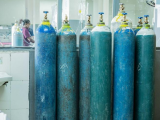(CIDRAP Source Osterholm Briefing) – It's summertime in America, Major League Baseball is about to celebrate its annual All-Star Game—and we are experiencing influenza activity throughout the world, including right here in North America. In my lifetime, a lineup featuring influenza and summer in this country is simply unprecedented, though hardly unexpected.
To be sure, the big game will receive substantial media coverage, and I hope my beloved American League and hometown hero Joe Mauer wins the game. But I know the most important story is not on the baseball field. Frankly, it's barely in the news. And when the novel H1N1 pandemic does gain public attention, a certain word is conveying a dangerous and false sense of safety: mild.
Not the 7th-inning stretch
Beware. We are in the early innings of this pandemic situation; a lot is yet to unfold. Now is not the time to take our eyes off the ball. I can only hope organizations like yours will use this time to better prepare for what could be a challenging time come this fall.
And I also realize how hard that might be, particularly if the public continues to think of the emergence of novel H1N1 as a media event of late April and early May and its continued occurrence as a "mild" pandemic, the term many government and public health officials have used to describe the current situation. Unfortunately, to date the pandemic has been largely mischaracterized in terms of its severity.
To its credit, however, the World Health Organization (WHO) has avoided using "mild" to describe the pandemic. In fact, WHO Director-General Margaret Chan has urged the world to see the current illness picture of novel H1N1 as a virus that can cause moderate to severe infections and to anticipate that its clinical spectrum (the full range of symptoms and severity) could substantially worsen with time. And just today, the Obama administration urged the US to plan and prepare, called such work "our shared responsibility," and said it is working to ready the nation for the "possibility of a more severe outbreak" of the pandemic virus.
Still, I worry very much that complacency in the northern hemisphere is replacing some of the over-the-top media coverage of late April/early May and undermining efforts to prepare the world for what I believe could be a very serious 2009-10 winter flu season.
Calling it as she sees it
Nobody has done a better job of trying to understand and explain the disconnect between what is happening now with the novel H1N1 pandemic and the future it holds than Helen Branswell, medical reporter from the Canadian Press. In "Constant use of 'mild' to describe swine flu misleading people about threat," published Jun 28, Branswell details the growing misconception between the reality of this pandemic, what it may hold for the future, and our misunderstanding of its threat. I urge you to read her piece and circulate it to your colleagues and leaders up the management chain who may mistakenly believe the H1N1 problem is over.
Branswell nails the issue in her first paragraphs:
Officialdom's mantra about swine flu—"it is overwhelmingly mild"—might seem incongruous if we knew the number of children, teens and young adults in ICU beds right now alive only because a breathing machine has taken over for their ravaged lungs.
The heavy reliance on the word "mild" could be creating a false impression of what is actually going on and what the world may face in coming months, some experts worry.
Peter Sandman, a risk communications guru from Princeton, NJ, suggests if authorities are trying to ensure people don't panic about the new H1N1 outbreak, they are concerned about the wrong thing.
"In North America, swine flu panic is much rarer than swine flu deaths," Sandman says. "The problem isn't panic or even excessive anxiety. The problem is complacency, both about what's going to happen and about what might happen."
As many of you already know, Peter is the Deputy Editor of the CIDRAP Business Source and truly one of the world's top risk communication experts. His comments in Branswell's piece are right on the mark.
A picture of what's to come?
Even if nothing changes about the clinical spectrum of this H1N1 infection, think about the impact it's having on countries like Argentina, Chile, and Australia where it has all but replaced the other two seasonal influenza A strains.
The pandemic is stretching the government and medical response capabilities of these southern hemisphere countries in the absence of an effective vaccine. (I will revisit the vaccine issue in detail in an upcoming column, but for now know that I don't hold out hope that US citizens will receive much pandemic vaccine before the seasonal flu season revisits us.)
Argentine financial markets and banks will close tomorrow as part of government efforts to fight an outbreak of novel H1N1. President Cristina Fernandez de Kirchner has sought to halt the spread of the virus the by closing schools, giving pregnant workers extended leave, and allocating emergency funding. Movie theaters have decided to temporarily shut their doors, while Brazilian airline Gol said on Wednesday it had seen a sharp drop in the number of passengers flying to Argentina.
A pandemic virus in its infancy
In just a few months we'll be entering the 2009-10 influenza season. As you look ahead, consider Branswell's words:
". . . as a human pathogen this virus is still a baby, despite its rapid global spread. No one knows what it is going to be when it grows up.
Some things are clear, though. Since most people seem to have no immunity to the virus —some people over 60 may have some—huge numbers will probably catch this flu over the next couple of years. In a relatively tight time frame, lots of people will come down with the flu—far more than would be seen during a regular flu year.
To understand that impact, think back to elementary school arithmetic. If the denominator (the total number of cases) gets substantially bigger, the total number of people falling gravely ill or dying (the numerator) will rise sharply, even if the proportion of severe cases (the percentage) doesn't change.
And sheer numbers could make the outbreak get nasty, fast.
I couldn't have said it better. Even if novel H1N1 doesn't mutate or reassort between now and the fall in a way that increases its ability to cause more severe disease, we're in for a serious and real challenge. And that's before even considering the possibility of the virus developing resistance to our current antiviral flu drugs.
Bottom line for your organization
Don't take a summer vacation from pandemic preparedness and business continuity planning. These next few months are precious. Think about all the things that you learned from your late April and May experience and work like hell this summer to do what you can to fix, upgrade, or replace them with a better response plan for the days ahead. I'm certain you'll not waste your efforts.




















